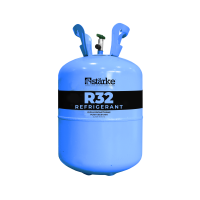Difluoromethane on:
[Wikipedia]
[Google]
[Amazon]
Difluoromethane, also called HFC-32 is an organofluorine compound with the formula CH2F2. It is a colorless gas that is used as a refrigerant.

Flammability Measurements of Difluoromethane in Air at 100 °C
Difluoromethane at Gas Encyclopaedia
IR absorption spectra
SDS Data sheet
{{Authority control Fluoroalkanes Halomethanes Hydrofluorocarbons Refrigerants

Synthesis
Difluoromethane is produced by the reaction of dichloromethane andhydrogen fluoride
Hydrogen fluoride (fluorane) is an Inorganic chemistry, inorganic compound with chemical formula . It is a very poisonous, colorless gas or liquid that dissolves in water to yield hydrofluoric acid. It is the principal industrial source of fluori ...
(HF) using SbF5 as a catalyst.
:
Applications
Difluoromethane is used asrefrigerant
A refrigerant is a working fluid used in the cooling, heating, or reverse cooling/heating cycles of air conditioning systems and heat pumps, where they undergo a repeated phase transition from a liquid to a gas and back again. Refrigerants are ...
that has prominent heat transfer and pressure drop performance, both in condensation and vaporization.
Difluoromethane is currently used by itself in residential and commercial air-conditioners in Japan, China, and India as a substitute for R-410A. In order to reduce the residual risk associated with its mild flammability, this molecule should be applied in heat transfer equipment with low refrigerant charge such as brazed plate heat exchangers (BPHE), or shell and tube heat exchangers and tube and plate heat exchangers with tube of small diameter.
Many applications confirmed that difluoromethane exhibits heat transfer coefficients higher than those of R-410A
under the same operating conditions but also higher frictional pressure drops.
Other uses of difluoromethane include its use as aerosol propellant and blowing agent.
Environmental effects
Theglobal warming potential
Global warming potential (GWP) is a measure of how much heat a greenhouse gas traps in the atmosphere over a specific time period, relative to carbon dioxide (). It is expressed as a multiple of warming caused by the same mass of carbon dioxide ( ...
(GWP) of HFC-32 is estimated at 677 on a 100-year time window. This is far lower than the GWP for HFC refrigerants it is replacing, but remains sufficiently high to spur continued research into using lower-GWP refrigerants.
Difluoromethane is excluded from the 1963 list of VOCs restricted by the United States Clean Air Act due to the ODP being zero.
References
See also
* R-410A, a refrigerant that is being phased out, and which R-32 is a popular replacement for * R-454B, another R-410A replacement *List of refrigerants
This is a list of refrigerants, sorted by their ASHRAE-designated numbers, commonly known as R numbers. Many modern refrigerants are human-made halogenated gases, especially fluorinated gases and chlorinated gases, that are frequently referred ...
External links
Flammability Measurements of Difluoromethane in Air at 100 °C
Difluoromethane at Gas Encyclopaedia
IR absorption spectra
SDS Data sheet
{{Authority control Fluoroalkanes Halomethanes Hydrofluorocarbons Refrigerants